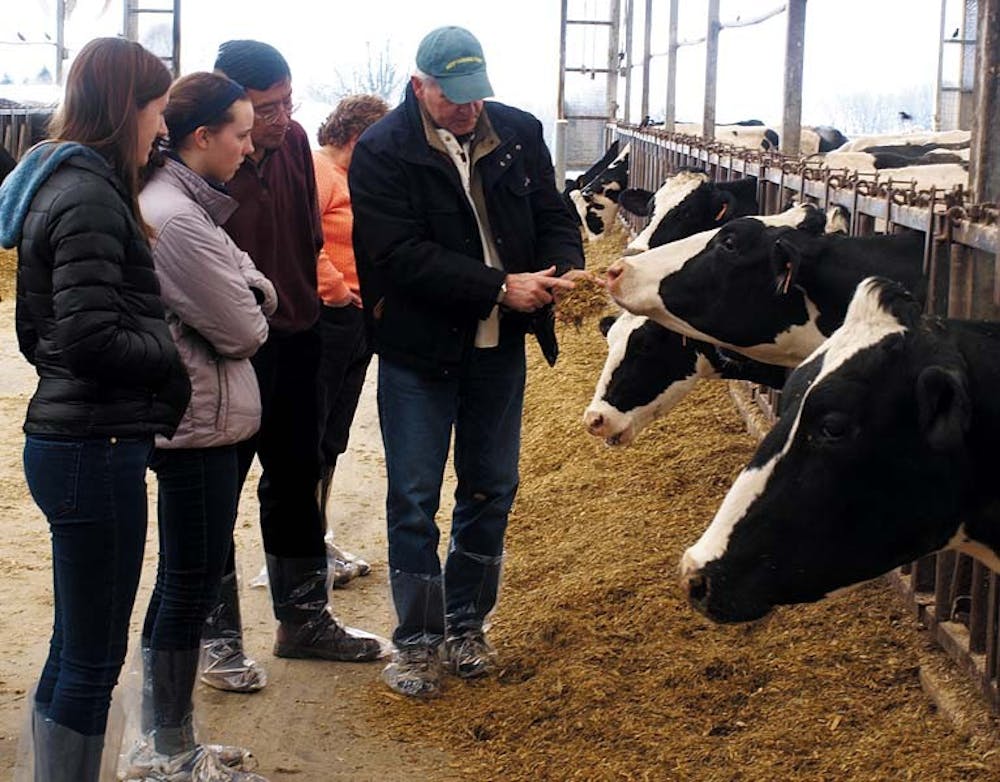
There’s more than just oinks and moos at Penn School of Veterinary Medicine’s New Bolton Center.
Located on 700 acres in Kennett Square, Pa., the center, a branch of Penn Vet, includes fully functioning cow and pig farms as well as a hospital for large animals.
Penn Vet founded the New Bolton Center in 1952 after deeming the Bolton Farm it owned just north of King of Prussia Mall not large enough. The mission of the center, according to Director of Development Jane Simone, centers on three concepts — teaching, research and service.
One of the major sections of the New Bolton Center is the dairy farm it owns and operates.
The Marshak Dairy, which opened in 1996, serves as a fully functioning farm for cows. All of the products the farm produces are sold to a cooperative of Land O’Lakes, who uses it to make a variety of dairy products like butter.
“We want to keep it running like a commercial dairy farm,” Veterinary Coordinator Jon Garber said.

There are 200 adult lactating cows, all of the Holstein breed, as well as 160 young female cows who have not yet begun lactating. Typically, a female cow has its first calf and begins lactating at approximately two years of age. Once this begins, the cows are milked twice per day.
Many Penn Vet students work part-time at Marshak, usually commuting on evenings or weekends. They help out in farm management as well as research.
Their experiments typically concern feedings, where researchers experiment with the benefits and detriments of different types of diets for the cows.
All the females cows are bred on site using artificial insemination. Helping the process are technicians from specialized bull centers, from where they purchase the semen that helps with the process. Marshak Dairy employees who have completed the certification process also assist.
No male cows are kept on site. In the event that a male calf is born, it is sold at auction at a beef market within a week of its birth.
All the lactating cows are kept under one “greenhouse-style” barn, according to Garber. This means that the walls and roofs are made of plastic with a metal frame, providing improved ventilation and natural light.
Marshak tries to secure the comfort of the cows during hot Pennsylvania summers through a large collection of circulating fans and a sprinkler system designed to wet the animals’ backs down.
Penn Vet student Andy Stas has worked part-time at Marshak for several years.
“The Marshak farm has given me the opportunity to learn and practice in an educationally focused environment when I otherwise would not have the opportunity,” he said in an email, mentioning he has learned many lessons about animal medicine and nutritional management of cows.
Just as Marshak operates as a functioning dairy farm, so too does the Swine Training and Research Unit. Approximately 4,000 piglets are born in the center each year, and are eventually sold as antibiotic-free meat to stores like Whole Foods.
Third-year Penn Vet student Chad Hundley volunteered in the Swine Unit in the summer of 2011.
He said the experience was rewarding because he “got to do a lot of stuff with pig medicine that you usually don’t get to do that early in the [Penn Vet] curriculum.”
Much of what he learned had to do with how to treat animals as a herd rather than how a veterinarian would treat an individual animal.
In addition to the medical learning, Hundley said it was helpful to see “how a farm works from a production standpoint.”
Another major part of the New Bolton Center is the George D. Widener Hospital for Large Animals, which provides Penn Vet students a chance to see a fully functioning animal care facility designed specifically for large animals.
The majority of the animals the hospital sees are horses, according to Simone, but Widener also sees everything from cows to sheep to llamas. The hospital deals with 4,500 to 6,000 cases per year.
“Just like medical students, you can’t teach vet students to become good doctors without seeing patients,” Simone said. The hospital offers residencies and internships just like the Hospital of the University of Pennsylvania.
The New Bolton Center also has a strong relationship with the horse industry surrounding it. The area is “very rich equine country,” and the center does everything it can to help, Simone said.
Many horses that have reached elite levels in horse racing and equestrian eventing have come through New Bolton.
In 2006, the racehorse Barbaro charmed the nation after winning the Kentucky Derby as an underdog before shattering his leg at the Preakness Stakes two weeks later. Immediately after, he was taken to the Equine Intensive Care Unit at the New Bolton Center for treatment.
The hospital still operates a “Barbaro Fund” aimed at raising money for patient care and expanding Widener Hospital.
The Daily Pennsylvanian is an independent, student-run newspaper. Please consider making a donation to support the coverage that shapes the University. Your generosity ensures a future of strong journalism at Penn.
DonatePlease note All comments are eligible for publication in The Daily Pennsylvanian.








